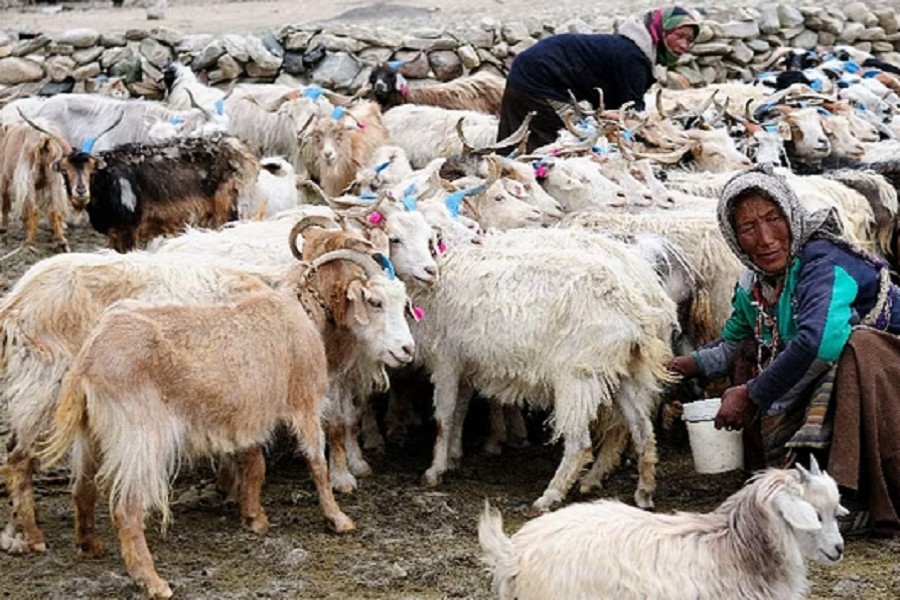When nomad Mohammed Rabbani and his family left the soaring April heat of their hometown to start their annual trek into the hills of Kashmir to graze their livestock, they took 400 sheep and goats with them.
But only about 200 animals will make the 260-km (186-mile) trip back to Rabbani's home in Rajouri, in the west of the Jammu and Kashmir region.
During their time in the hills, heavy rains, flooding, and unseasonal snowstorms killed half the family's livestock.
"I have never seen such harsh conditions before," said the 52-year-old herder from the Gujjar nomadic community, noting that last year he lost about 30 head of livestock to extreme weather.
As Rabbani and his family packed their possessions to start their journey down from Aru Valley, he recounted how a sudden rainstorm had triggered flash flooding as they travelled toward the Marsar alpine lake.
"Some of my livestock got washed away by gushing waters, and my son was also badly injured," he said.
The tribal nomads of Jammu and Kashmir have long timed their migration into the hills with regular seasonal weather patterns, allowing them to make an income and put food on the table, according to Reuters.
But now harsher storms and sudden floods are disrupting centuries of migratory tradition, battering nomadic communities and forcing many families to consider giving up their herding culture.
"This year, the loss (to extreme weather) set new records. Nearly 50 per cent of the livestock belonging to nomads was killed," said Zahid Parwaz Choudhary, president of the Gujjar Bakarwal Youth Welfare Conference (JKGBYWC), a non-governmental organisation working with nomads in the region.
"If climate change worsens in the coming years, the nomads will have no option but to end their centuries-old migratory lifestyle, which will eventually affect their cultural legacy and the state's economy."
I LOST EVERYTHING'
Ruksana Bano, 25, whose family is travelling with Rabbani's, quietly wept as she spoke about how the early, heavy snow in Kashmir's highlands this year contributed to the loss of her baby.
While heavily pregnant with her second child, Bano had to help her husband clear thick snow – which had arrived unusually early – from their tent each night.
Sometimes, the snow or rain was so heavy they couldn't set up their tent and would have to sleep outside on the cold, wet ground, she said. They lost 80 sheep to the harsh weather.
When Bano's family got to the hills of Aru Valley, she suddenly developed labour pains. It took them four hours to trek downhill to the nearest town of Pahalgam through heavy rains and fierce winds.
By the time they reached the hospital, the baby had died.
"I lost everything. I want to die here. The untimely snowfall and rain had already taken away our shelters and livestock, now it has taken my baby, too," she said, tears rolling down her cheeks as she prepared food with her two-year-old daughter in her lap.
"It's better to stay back at our homes rather than face extreme bad weather and lose everything."
According to last year's annual report by India's meteorological department, the past decade has been the country's warmest since records began in 1901.
Triggered by rising temperatures, India has been battered by increasingly frequent and intense climate disasters over the past 10 years.
Flash floods, storms, avalanches and landslides are making the Kashmir mountains more dangerous for the region's herders, whose Gujjar and Bakarwal communities make up more than 8% of the population of the state of Jammu and Kashmir.
At the same time, cold snaps are killing alpine pastures they rely on to feed their animals, said Shakil Ramshoo, an earth sciences expert at the Islamic University of Science and Technology (IUST) in Jammu and Kashmir.
"Since the majority of (nomads) have meagre means of support, their vulnerability to the effects of climate change is greater than that of other parts of the population," he said.
CALLS FOR COMPENSATION
The government is doing little to help, said Choudhary at JKGBYWC, which often represents herder families who bring complaints and demands to authorities over income lost to extreme weather.
He said there have been many cases this year of nomadic families losing all their livestock to snowfall and being left with no source of income.
Ramshoo at IUST said the government needs to do more to measure the financial impact of climate change on marginalised groups such as nomads and use the data to initiate "robust" climate change adaptation measures.
Jammu and Kashmir's Tribal Affairs Department did not respond to several requests for comment, but at the start of this year's migration, the state government said it would provide transportation to help nomads make it to the highlands faster to give their animals more time to graze in case the snow came early.
Choudhary said that transportation will help families get into the hills more quickly and safely, but stops short of protecting herds while they are up in the highlands, exposed to extreme weather during months of grazing.
"The actual problem starts on the mountains, where there is no mode of communication or transport facilities," he said.
In the Aru Valley, Mohammad Ayoub, 40, watched over his remaining sheep and goats as he lamented the loss of most of his herd to snow and cold.
He had planned to use what he earned selling some of his livestock to feed his family. Instead he has had to pay to treat his surviving animals to keep them alive after they developed diseases and lost too much weight because of a lack of pasture.
Herding has become too precarious, he said, adding that he and his family might have to stay home next year and work as labourers.
"This year, I'm returning with only 20 per cent of my livestock," he said. "If the situation remains the same, I don't think I will be able to come next year."


